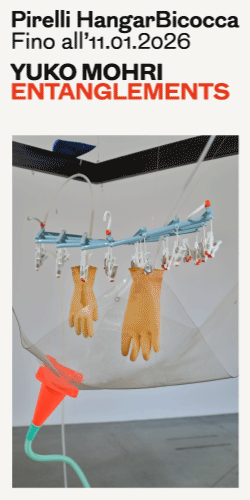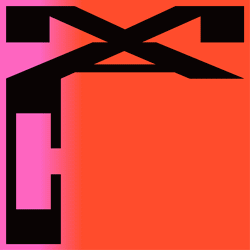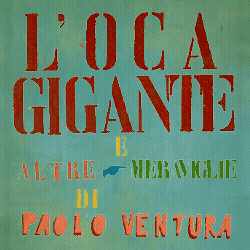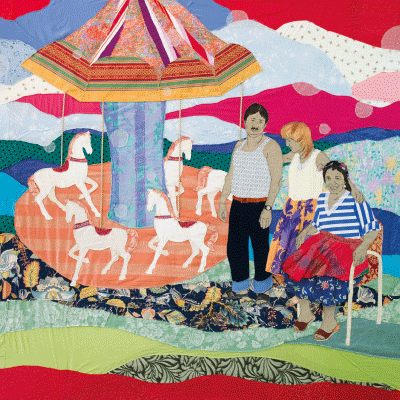[nemus_slider id=”58355″]
Ilya Smirnov (Mosca, 1984). Vive e lavora a New York.
In questo preciso momento sono per lo più occupato con il disegno di oggetti in fiamme, con quello del fuoco e della lievitazione del fumo, che il vento a volte muove su un lato; candele e torce incandescenti, nubi e cavalieri con lance e alti elmetti, cavità di un terreno che sgocciola e propaga onde increspate, portali, archi e paletti di legno verticali, linee irregolari e ovali distorti redatti in maniera semi-automatica o come se si stesse provando dolore nel tenere la penna in mano mentre si disegna.
Alcune immagini sono realizzate al buio come rappresentazione di un motivo che cambia ad occhi chiusi. L’immagine completata porta con sé l’impronta nel basso del foglio di carta, per lo più linee eseguite con forte pressione, che vengono ritracciate in seguito. Se la carta fosse abbastanza sottile quest’azione potrebbe essere ripetuta ulteriormente, fino a quando la linea diventa completamente spezzata o eventualmente ridotta a pochi punti. Sono molto attratto dal fatto che, quando si scrive una frase sulla carta, vi è una certa somiglianza tra la scrittura e la scrittura dei nostri avi ed è qualcosa sulla quale si ha poco controllo, come se la mano ed il suo movimento appartenessero a qualcun altro.
Kareem Lotfy
Kareem Lotfy converge nelle sue opere due dimensioni apparentemente opposte: da un lato, la cultura digitale, dall’altro, la ricca storia culturale del suo paese nativo, l’Egitto. Lotfy realizza disegni, impiega modelli algoritmici, forme arcaiche e strutture pittoriche (spesso sotto le restrizioni di primordiali software CG), che conferiscono al suo lavoro un carattere futuristico, nel quale però permane in maniera decisiva l’influenza del simbolismo antico, come quello presente nei tappeti e nelle antiche calligrafie. Kareem Lotfy è nato al Cairo, in Egitto, nel 1985. Attualmente vive ad Amsterdam, dove è in residenza presso la Rijksacademy.

Ilya Smirnov (Moscow, 1984). Lives and works in New York.
At the given moment I’m mostly busy with drawing objects on fire, fire and rising smoke that wind carries to the side sometimes, candles and flaming torches, clouds, horse riders with spears in prolonged helmets, cavities in the soil leaking and emitting billowy waves, gates and arches and vertical wooden stakes, uneven lines and awry ovals drawn in semi-automatic manner and as if it’s painful to hold the pen and make a motion with it. Some pictures are made in the darkness as the representation of the changing pattern visible with eyes closed. The finished picture leaves the imprint on the sheet of paper underneath, mostly the lines executed with strongest pressure, they also get traced afterwards. If the paper is thin enough this action can be repeated further and further, till the line gets entirely broken and is eventually reduced to a few dots. I’m very attracted to the fact that when you write a sentence on paper there is a similarity between your handwriting and the handwriting of your older relatives and it’s something that you have little control over, like the hand and it’s movement belong to someone else.
Kareem Lotfy
Kareem Lotfy combines two seemingly opposite worlds in his work: on the one hand digital culture and on the other the extremely rich cultural history of his native Egypt. He makes intuitive drawings under the restrictions of primitive CG software. Due to the limited capabilities of these tools, rendering systems and the visual output from them, new dimensions of cognitive possibilities open up to the artist and the viewer. The resulting pieces are attempts to capture the experience of seeing patterns or connections in random or meaningless data (phenomenon of apophenia, for example). Lotfy works with drawings, algorithmic patterns, archaic forms and pictorial structures that give his work a futuristic character, but the influence of ancient symbolism as found in carpets and calligraphy is still visible too. Kareem Lotfy was born in Cairo, Egypt in 1985. Currently he lives in Amsterdam where he is resident artist at the Rijksacademy.

63rd – 77th STEPS is a project space for contemporary art founded and run by the artist Fabio Santacroce. It is incorporated on the last segment of a communal staircase (between the 63 ° and the 77 ° step), inside a building from the beginning of the XX century in Bari. Site-specific exhibitions are alternated with off-site and online projects meant as physical and metaphorical extensions of this residual place. 63rd-77th STEPS strains and investigates the limits and potentialities of the periphery, redefining its spatial and temporal framework within a hyper-connected, hegemonic geography









